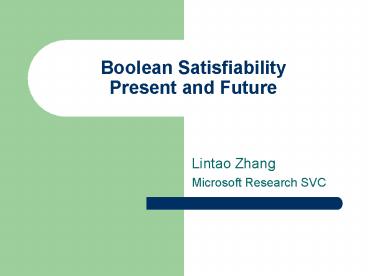Boolean Satisfiability Present and Future - PowerPoint PPT Presentation
Title:
Boolean Satisfiability Present and Future
Description:
We cannot bet on any breakthrough without fundamentally change the way the algorithm works. i.e. Don't bet on another 3 orders of magnitude speed up in the next 10 ... – PowerPoint PPT presentation
Number of Views:43
Avg rating:3.0/5.0
Title: Boolean Satisfiability Present and Future
1
Boolean Satisfiability Present and Future
- Lintao Zhang
- Microsoft Research SVC
2
SAT Introduction
- Deciding the satisfiability of Boolean formulas
- SAT Propositional ( usually in Conjunctive
Normal Form (CNF) ) - QBF With quantifiers
- Many driving forces
- Verification
- Electronic Design Automation (EDA)
- Artificial Intelligence
- Operational Research
- Physics ???
- Where is SAT used in our context?
- A basic building block for the reasoning engine
- Reasoning on Boolean domain
- Driving branching and backtracking for search
- Model Checking
- Decision Procedures
- Etc.
3
SAT Solvers Current State-of-the-Art
- Tremendous performance improvements on
Propositional SAT solvers in the last decade - Speed increased by at least 3 orders of magnitude
- We regularly solve SAT instances with tens of
thousands variables and clauses - Example
- Microprocessor verification, Bounded Model
Checking, 14 Cycles - 1 million variables, 10 million literals
initially - 200 million literals in added clauses
- 30 million literals finally
- 4 million clauses initially
- 200k clauses added
- 1.5 million decisions
- 3 hours run time
4
SAT Solvers Current State-of-the-Art
- Non performance related improvements of SAT
solvers - Explanatory SAT solver
- UNSAT Unsatisfiable core extraction
- SAT Minimal model extraction
- Interpolation using SAT solver
- Checkable proof of unsatisfiability
- On line progress report
- In the last several years, SAT solver changed
from a toy with only academic interest to become
a powerful and feature rich deduction method
capable of industrial strength applications.
5
Can we increase the SAT solver speed even more?
- Yes. Better heuristics and better implementations
are proposed everyday - But the improvements are incremental
- DPLL is the dominating algorithm for SAT solving
for more than 40 years - Basic DPLL algorithm is proposed in 1962
- Learning and non-chronological backtracking
(1996) - Careful implementation and tuning (2001)
- 2-Literal Watching BCP, VSIDS decision heuristic,
1-UIP learning, etc. - Whats going on?
- Better decision/branching heuristics
- Better learning and garbage collection schemes
- Leverage the structure of the Boolean formula
- Whats next?
- We cannot bet on any breakthrough without
fundamentally change the way the algorithm works - i.e. Dont bet on another 3 orders of magnitude
speed up in the next 10 years.
6
SAT Solver as a White Box
- Traditional usage of SAT as a Black Box
- Translate the problem into a monolithic CNF
instance - Throw it to the SAT solver and pray
- Used to work well
- To squeeze the last bit of performance out of a
SAT solver, current applications need to treat
SAT as a White Box - We need to use the knowledge about the
application to help the SAT solver - Input to the SAT solver may be a Boolean formula
combined with - Branching suggestions
- Domain specific implications
- Continuous interaction because of abstract and
refinement - SAT engines need to be expandable, with cleanly
defined interfaces. - What can the applications offer?
7
QBF Quantified Boolean Formulas
- Many applications stress SAT solver because of
quantifications - Eliminate quantification by expansion the
formula becomes exponentially large - Eliminate quantification by solution enumeration
SAT solver is bad at this - Unlike SAT, QBF just started to attract interests
from researchers in the last couple of years - No predominant algorithm
- DPLL search
- Resolution
- BDD
- And many other approaches
- Quantification elimination is hard (exponential
in space), while deciding the satisfiability of a
QBF may not be. - Will there be a breakthrough in the near future?
- Much more probable than a breakthrough in SAT































